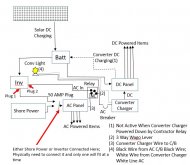Hi all
I’m just about to go from the test bench, into the caravan. And as I was planning the rv install and 230v I got thinking.
Currently the shore power runs into a safety switch, which loops to 2 power circuits and the ac circuit.
The current battery charger runs off a standard power point off the second power circuit. (No inverter currently)
When shore power in on, the charger is on. It’s under a bench and a pain to get to...
New setup, I was going to hook the inverter output into the main safety switch to power all circuits in the same manor that shore power would.
However, thinking about this, when the inverter is on, the all in one units charger would therefore activate.
Does anyone know how to get around this. Is there some sort of setting inside the mpp/Easun inverters that solves this? Am I missing something obvious?
Am I best to wire the charger gpo to an external switch and have to turn it on to charge? (I am hacking he inverter power switch in this way)
Thanks in advance
I’m just about to go from the test bench, into the caravan. And as I was planning the rv install and 230v I got thinking.
Currently the shore power runs into a safety switch, which loops to 2 power circuits and the ac circuit.
The current battery charger runs off a standard power point off the second power circuit. (No inverter currently)
When shore power in on, the charger is on. It’s under a bench and a pain to get to...
New setup, I was going to hook the inverter output into the main safety switch to power all circuits in the same manor that shore power would.
However, thinking about this, when the inverter is on, the all in one units charger would therefore activate.
Does anyone know how to get around this. Is there some sort of setting inside the mpp/Easun inverters that solves this? Am I missing something obvious?
Am I best to wire the charger gpo to an external switch and have to turn it on to charge? (I am hacking he inverter power switch in this way)
Thanks in advance




